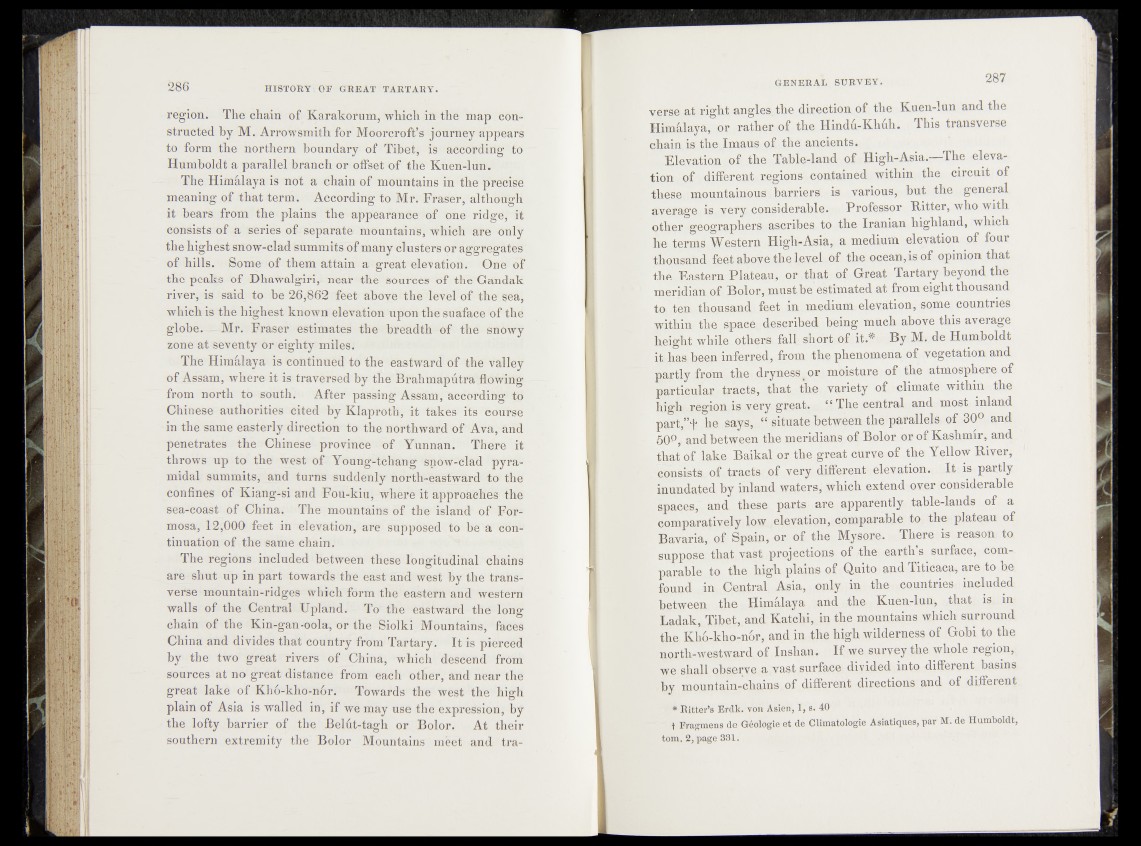
region. • The chain of Karakorum, which in the map constructed
by M. Arrowsmith for Moorcroft’s journey appears
to form the northern houndary of Tibet, is according to
Humboldt a parallel branch-or «offset of the Kueffi-iun’.
" The Himalaya is not a chain of mountains in the precise
meaning of that term. According to Mr. Fraser, although
it bears from the plains the appearanceJ'of one ridgC^'it
consistsrof a nerl^ of; separate mountains, which are M
the highest snow-clad summits of many clusters or aggregates
of hills. Some of them attain a great elevation. ;
the peaks of Dhawalgiri,-near the sources of the Gandak
river, is said to be 26,862 feet above the level-of the sCaj,
which is the highest known elevation upon the suaface -'of-the
globe.—Mr. Fraser estimates the breadth^oT the snowy
zone at seventy or eighty miles.
The Himalaya is continued to the eastward of the valley
of Assam, where it is traversed by the Brahmaputra .flowing
from north to south. After passing Assam, aceb^rdrbg* to
Chinee authorities cited by Klaproth, it takes its 'edhrse
in the same easterly direction to the northward of AVa^nnd
penetrates the Chinese province of Yunnan. There 7it
throws up to the west of Young-tehang ;snow-clad pyramidal
summits, and turns suddenly north-eastward to-the'
confines of Kiang-si and FoU-kiu^ where it approaches the
sea-coast of China. The mountains of the island' of Formosa,
1 2 ,0 0 0 feet in elevation, are supposed to bhra’‘continuation
of the same chain.
The regions included between these longitudinal chains
are shut up in part towards the east and west by the transverse
mountain-ridges which form the eastern and western
Walls of the Central Upland. To the eastward the-long
chain of the Kin-gan-oola, or the Siolki Mountains, faces
China and divides that country from Tartary. It is pierced
by the two great rivers of China, which descend from
sources at no great distance from each other, and near the
great lake of Kh6 -kho-n6 r. Towards the west the high
plain of Asia is walled in, if we may use the expression, by
the lofty barrier of the Belht-tagh or Bolor. At their
southern extremity the Bolor Mountains meet and trayer^
atiright angles the direction, of the Kuen-lun and the
Hiiilay a, or rather of the Hindu-Khuh. This transverse
chain^s- th^m^i%o&khe ancients.
Elesatic^s»0Jt the Table-land,of High-Asia^The elevaf
tion of' dif^rent>,Regions cp^gj^edbwithin the, circuit of
these, mountainoujJIag^jifrsWis .various, but, the .general
average is. very,cpnsiderable^^j3?iofessor- Bitter,, who with
ntti«at» ^pngr^php.rS^aSjCBitbes^ tb j,the Iranian highland, which
he terms jjjjg&farp. HjghrAsia* a^pdioftn .elevation of fen*
tlimiflayirl .feat above thn^apifa of the* <j^eab% is of opinion that.
theVilistern P la fe jp p r .tlia ^ tf e pW Tartarjhbeyond the
meridilflpABolor^^gjhstbp*estimated at feonj^Lght thousand
to. ,teoy tfeopsanA^prt i®y me^itim .okpv^tjpn ,> countries
within thd^pace described being mpch ^hove this average
height.while o g ^ f a l l short;oflit-.* By;M. de Humboldt
ihvhas been inferred, I 501» the pbenpmeha oft^feegetation and
partly frOm dbpi^^aes^or m a tu re ; of the atmosphere of
particular tracts, that^be, variety of. climate within,'the.
high ,region;ds,yery “ The central and most inland
part,”+ he says« / 4 situate het^eemthe paralleJ^^feW and
- 5Q£, and Between the meridians of Bpjl^r 0&o£ Kashmir, and
that of jake Baikal or ta lp e a t cprveof the bellow Biver,
. consists, of tracts of very different«elevation.. I t; is - partly
inundated hy inland waters, which;§¥tend overlconsiderable I
spaces, and these parts are apparently .tablelands of a
comparatively low ,e!evati,e^n,$<!pmparahle,^s-thef>plafeau of
Bavaria, of Spain, or of ihe MySpjse. Therefdgf reasons to
Euppose: that vast projections of the earth’s s»$fa^e,pcom-.
parable to the high plains of Quito and Titicaca, are to he?
found inj;Central Asia, only, in. th&'countries. included
between the Himalaya and the Kupn-lun, that. is. in»
Ladak, Tibet,.and Katchi, jn the mountains which surround
the Kb6*khp-n6 r, and in the high wilderness O.fjGoM to the
north-westward of Inslian; If we^survey the whole region,|
we shall observe a,vast surface divided intp different basins
by mountain-chains,pf different directions and of. different
* Bitter’s Erdk. Vbn1 iA.sien, 1, s. 40
- - t Fragmens de G6ologie et de Climatologie AsiatiqueS, par M. de Humboldt,
tom. 2, page 331.